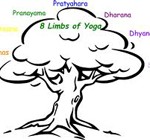by Kara-Leah Grant
I’ve been contemplating a few things lately, both while on my mat and off my mat. Things like how yoga and business mix, what it means to be a yoga student, what it means to be a yogi, how our shadow sides present themselves and affect both us and the people around us, and what life is really all about. I know, big stuff.
Something that’s mean tying it together for me, over and over and over again, is that how we choose to behave when the pressure is on reveals how mature we are, or how far along the spiritual path we are.
It’s easy to be all bliss, love, rainbows and daisies while taking a yoga workshop. It’s tough to stay grounded, present and open when the car’s broken down, the baby’s screaming and you’re stuck in rush hour traffic.
And as I muse over all these aspects of life – yoga & business, being a yoga student/yogi, the shadow/light sides of self and the nature of life… I come back, time and time again to the yamas and niyamas. Often these are described as the ‘dos & dont’s’ of life.
I prefer to think of them more as the suggestions on how to deal with people around us and our attitude toward ourselves. Taking these suggestions on board makes life easier, reducing both the amount of drama and the amount of karma we create.
Despite being a practicing yoga student for more than ten years and a teacher for five or so, I still struggle to remember what the yamas and niyamas are, and I can never list all five of each. The ones I do remember easily, like Satya, or Ahimsa, I feel like I only really have an intellectual understanding of them. (See below for a full list of all the yamas and niyamas).
Yet the yamas and niyamas are limb number one and two in Patanjali’s Eight limbs of yoga. If I’m meant to be a serious yoga student, working towards self-realization, I need to not just learn what the yamas and niyamas are, I need to embody them within my life.
I need to be living them out.
It’s always interesting for me to note that asana – which is where most of us start yoga – is number three of Patanjali’s Eight Limbs. Now these eight limbs aren’t sequential, that is, you don’t master one limb and then move on to the next. All his eight limbs of yoga work in conjunction with each other. Which means they are all just as important as each other and if you’re learning limb #3 – asana – and nothing else, are you really learning yoga at all?
So here’s what I’m going to do.
Every week I am going to choose one of the yamas, and commit to living it out in it’s entirety that week, and then writing about my experience here. I’ll explore how these concepts – these wise characteristics – apply to me. I don’t expect that I’ll be able to necessarily be perfect in my execution of this, I hope I will be able to pay total awareness to the results I create when I neglect to live out fully the yama.
It’s going to take me five weeks to cover all the yamas, and then I’ll likely take a break before moving on to the niyamas.
I’m also going to invite my readers and The Yoga Lunchbox Facebook fans to join me for the ride. Each week, I’ll announce which yama is being studied and lived, and invite you to join me in making it a part of your life too. I’m always keen to hear from my readers about their experiences, so you can contact me, leave a comment, or add a wall post to let me know how you got on.
As part of my week, I’ll be reading up in my favourite yoga books, and through Google all about the yama I’m working with. And I’ll seek to apply it to my life, and to the yoga class I teach that week.
This week, I’ll start with the first yama in my list below – Ahimsa.
I have covered this before (click on Ahimsa to see all posts with that tag), but never within the context of my own life. It’s going to be interesting. It’s going to take mindfulness. It’s going to require presence. Every morning, I’m going to need to remind myself that It’s all about Ahimsa this week baby… and this doesn’t mean I “drop” all the other yamas and niyamas. Oh no, I’m still doing my best to incorporate those into my life. But the one I’m going to be studying, observing, writing about… that’s Ahimsa. I hope you’ll join me for the ride!
The five yamas are wise characteristics we seek to develop because this creates health and happiness of us and society:
1. Ahimsa – Compassion for all living things, non-violence, non-harming, having a considerate and thoughtful attitude to other people and things.
2. Satya – Commitment to Truthfulness, and the discernment to know when to speak the truth and when to remain silent.
3. Asteya – Non-stealing, not taking what doesn’t belong to us, not taking advantage of people or things.
4. Brahmacharya – Sense control, an attitude of the mind toward all sense objects.
5. Aparigraha – Neutralizing the desire to acquire and hoard wealth, taking only what is necessary, only what we have earned.
The five niyamas are the personal attitude we adopt towards ourselves so that we may live more soulfully:
1. Sauca – Purity, both inside and out. It means we keep our bodies clean, we practice asana and pranayama to clean the insides of our bodies, and we practice meditation to cleanse the mind of it’s disturbing emotions like hate, greed, delusion and pride.
2. Santosa – Contentment. Simply being happy with what we do have, rather than being happy about what we don’t happy. Being happy in child rather than unhappy we can’t do wheel.
3. Tapas – Disciplined use of our energy.
4. Svadhyaya – Self study, cultivating self-reflective consciousness so that we can truly see who we are – shadow and light.
5. Isvarapranidhana – Celebration of the Spiritual, laying all our actions at the feet of God. Surrendering to Divine Will.



This is really wonderful to see Kara-Leah. I recently wrote a Yoga Lifestyle essay for yoga instructor course and incorporating the Yamas and Niyamas was a critical aspect to the writing piece. I too have struggled to remember them all and before moving house I stuck post it notes up a day at a time to help. I like your idea on one a week and considering the amount of times I have seen the word “Ahimsa” lately, think it’s probably a great way to start! Many thanks 🙂
Hey Kate,
My pleasure Kate. It’s wonderful to see people still finding value in these articles months & sometimes years after they were written.